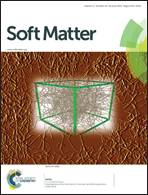Confronting the complexity of CNT materials†
Abstract
The morphology of commercially available carbon nanotube materials is often much more complex than the term “carbon nanotube” (CNT) would imply. Commercial CNT materials are typically composed of roughly spherical CNT domains having a highly ramified internal structure and a size on the order of microns. Clearly, such structures cannot reasonably be modeled as “rods”. To address this problem, we first perform molecular dynamics simulations (MD) to generate structures similar to those measured experimentally, based on the presumptions that CNT domains are composed of worm-like cylinders having observed persistence lengths and that these CNTs are confined to spherical domains having the observed average domain size. This simple model generates structures remarkably similar to those observed experimentally. We then consider numerical path-integral computations to calculate the self-capacitance C and intrinsic conductivity [σ]∞ of these CNT rich domains. This information is then incorporated in a generalized effective medium theory to estimate the conductivity of bulk composite materials composed of these complex-shaped “particles”. We term these CNT structures “tumbleweeds”, given their evident morphological similarity to this naturally occurring growth form. Based on this model, we find that the conductivity percolation threshold of the tumbleweeds can be quite low, despite their quasi-spherical average shape. We also examine the structure factor S(q) of the CNT-rich domains as function of the number N of CNTs within them, to aid in the structural characterization of CNT nanocomposites. The structure factor S(q) of our model tumbleweed is found to resemble that of hyperbranched, star and dendrimer polymers, and also domain structures observed in polyelectrolytes. Commercial CNT materials at high loading should then have physical features in common with suspension of “soft” colloidal particles by virtue of their deformability and roughly spherical shape.


 Please wait while we load your content...
Please wait while we load your content...